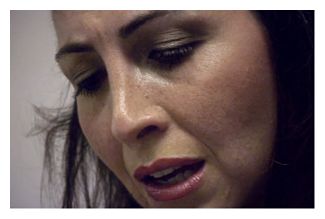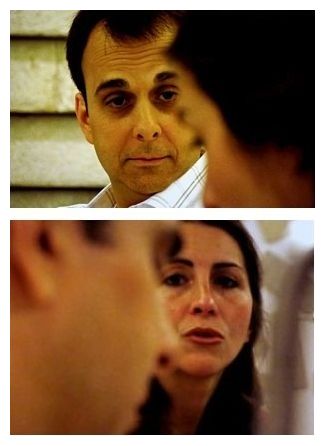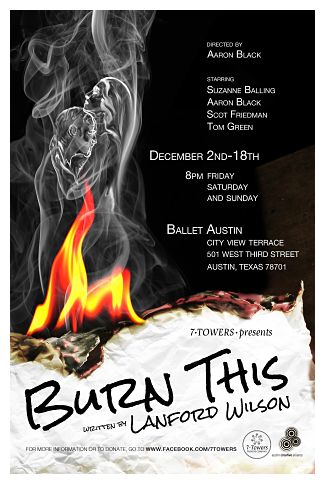Review: Burn This by 7 Towers Theatre Company
by Michael Meigs
For this intimate, powerful urban drama the setting is superb: a balcony-level studio downtown with a kitchen, a vantage point from which one could study passing vehicles, lines of close-parked cars, and pedestrians hurrying to music venues nearby. It's a "studio" in every sense of the word: with the addition of a minimum of furniture it represents a New York loft. Situated in the Ballet Austin building at 501 West Third Street, it's an appropriate practice space for the principal character Anna, a dancer aspiring to take on choreography. She says nothing in the opening moments, wrapped in music and apparently lost in an inner world , moving in a deliberate, expressive non-dance, settling on the beanbag chair and pillows right at our feet.
 And it's a studio almost in the cinema sense. The 7 Towers Theatre Company performs close up for a limited audience seated on perhaps twenty hard folding chairs along the perimeter of the room. The action is so close before you and the faces are so near that you could be sitting in the darkness before the big screen -- except that these people are real and immediate, and they are using this studio in which you're no more than hovering eyes and consciousness.
And it's a studio almost in the cinema sense. The 7 Towers Theatre Company performs close up for a limited audience seated on perhaps twenty hard folding chairs along the perimeter of the room. The action is so close before you and the faces are so near that you could be sitting in the darkness before the big screen -- except that these people are real and immediate, and they are using this studio in which you're no more than hovering eyes and consciousness.
Ballet Austin posts a prominent disclaimer at the ticket table, for understandable reasons. The strong language, sexual subject matter, and adult story have little to do with the stereotypical world of toe shoes, tutus and bar exercises, despite the fact that dance is a vital element of Wilson's tale.
 Anna has been sharing this loft space with two men, both of them gay. Larry works in advertising, a milieu rich for cynical anecdote, and Robby is her gifted collaborator in dance. Or rather, was -- for as we hear from an increasingly agitated Anna, Robby has just died in a random boating accident. She has come stumbling back from the nightmare world of funeral and family, where everyone insisted on categorizing her as Robby's girlfriend. Unable to sleep, pulling at the vodka bottle, Anna relates these events to Larry and to Steve, the writer just returned from a Canadian trek, a friend who'd probably like to become more than a friend.
Anna has been sharing this loft space with two men, both of them gay. Larry works in advertising, a milieu rich for cynical anecdote, and Robby is her gifted collaborator in dance. Or rather, was -- for as we hear from an increasingly agitated Anna, Robby has just died in a random boating accident. She has come stumbling back from the nightmare world of funeral and family, where everyone insisted on categorizing her as Robby's girlfriend. Unable to sleep, pulling at the vodka bottle, Anna relates these events to Larry and to Steve, the writer just returned from a Canadian trek, a friend who'd probably like to become more than a friend.
New York -- "the City," as if there were only one city worth considering for aspiring artists and talented professionals -- in its profusion, diversity and antagonisms is a profoundly lonely place. I remember it well; once upon a time we lived for a summer in a crummy little sublet on West Charles Street in the Village; we came within hours of paying "key money" to the departing tenant of a fourth-floor walkup on West 10th Street. The space shared by Anna, Larry and Robby is far tidier and better furnished -- with a functional kitchen, accessible through the doorway in the wall that becomes center stage -- but it is permeated with the same promise and uncertainty.
Lanford Wilson's dialogue is sharp and urban, yet revealing. Anna's protected world has been violently jarred and is upset still further by the unexpected appearance of Robby's brother "Pale." Pale is in his mid-thirties, arrogant and foul-mouthed, impatient, hopped-up and nearly burned out. These three men circle around Anna, each wanting her in a different way as she struggles to deal with her grief and to fulfill dead Robby's ambitions for her to go into choreography. It's a riveting evening of theatre: urban souls seeking friendship, sex and one another.
 Aaron Black's frighteningly convincing portrayal of Pale is monumentally good -- the fierce solarization of the neutral males he embodied in Susie Gidseg's play di[verge] this past summer. In body attitude, phrasing, accent, glare and costume he's the guy struggling in the urban wastes of New Jersey. We as outside observers initially cannot see why Anna is vulnerable to his swaggering, but we gradually understand that Pale must represent for her a macho heterosexual recasting of his dead brother. Burn This presents without polemic a knowledgeable, sensitive study of the complex relations between a straight woman and gay men. Anna's deep affection for the dead Robby twists unwillingly into a conflicted passion for Pale. Scott Friedman as Larry is apartment mate, observer, chorus, confidante and echo of Robby as this destructive dance is underway. Tom Green as Burton the writer is the rational heterosexual alternative: toned, moderate, diffident and protective but incapable of torching Anna's affections.
Aaron Black's frighteningly convincing portrayal of Pale is monumentally good -- the fierce solarization of the neutral males he embodied in Susie Gidseg's play di[verge] this past summer. In body attitude, phrasing, accent, glare and costume he's the guy struggling in the urban wastes of New Jersey. We as outside observers initially cannot see why Anna is vulnerable to his swaggering, but we gradually understand that Pale must represent for her a macho heterosexual recasting of his dead brother. Burn This presents without polemic a knowledgeable, sensitive study of the complex relations between a straight woman and gay men. Anna's deep affection for the dead Robby twists unwillingly into a conflicted passion for Pale. Scott Friedman as Larry is apartment mate, observer, chorus, confidante and echo of Robby as this destructive dance is underway. Tom Green as Burton the writer is the rational heterosexual alternative: toned, moderate, diffident and protective but incapable of torching Anna's affections.
Suzanne Balling's complexity and patent emotion are the center of this conflagration. She is profoundly attractive, both sexually and intellectually. Those qualities arise both from the character and from the actress.

Only one moment ripped the fabric of this evening. In the second act the
drunken, desperate Pale physically attacks Burton, who is supposed to be an instructor in martial arts. Paul Schimelman's fight choreography was simply unconvincing -- perhaps because it was so difficult in those quarters to hide Pale's pulled punch, or perhaps because Tom Green simply didn't have the smoothly aggressive, practiced moves expected of a sensei in Tae Kwan Do or other Asian fighting disciplines.
That thirty seconds disappears quickly in the two hours of rich and challenging urban story that Lanford Wilson and these four gifted actors are presenting to you. Burn This is the most impressive ensemble piece I've seen in Austin this year. I would go back to see it again -- but I'm not sure that I could endure its aching intensity.
Review by Adam Roberts in the Austin Chronicle, December 8
EXTRA
Click to view the program for Landford Wilson's Burn This by 7 Towers Theatre Company
Hits as of 2015 03 01: 1972
Burn This
by Lanford Wilson
7 Towers Theatre Company
301 W. 3rd Street
Austin, TX, 78701
